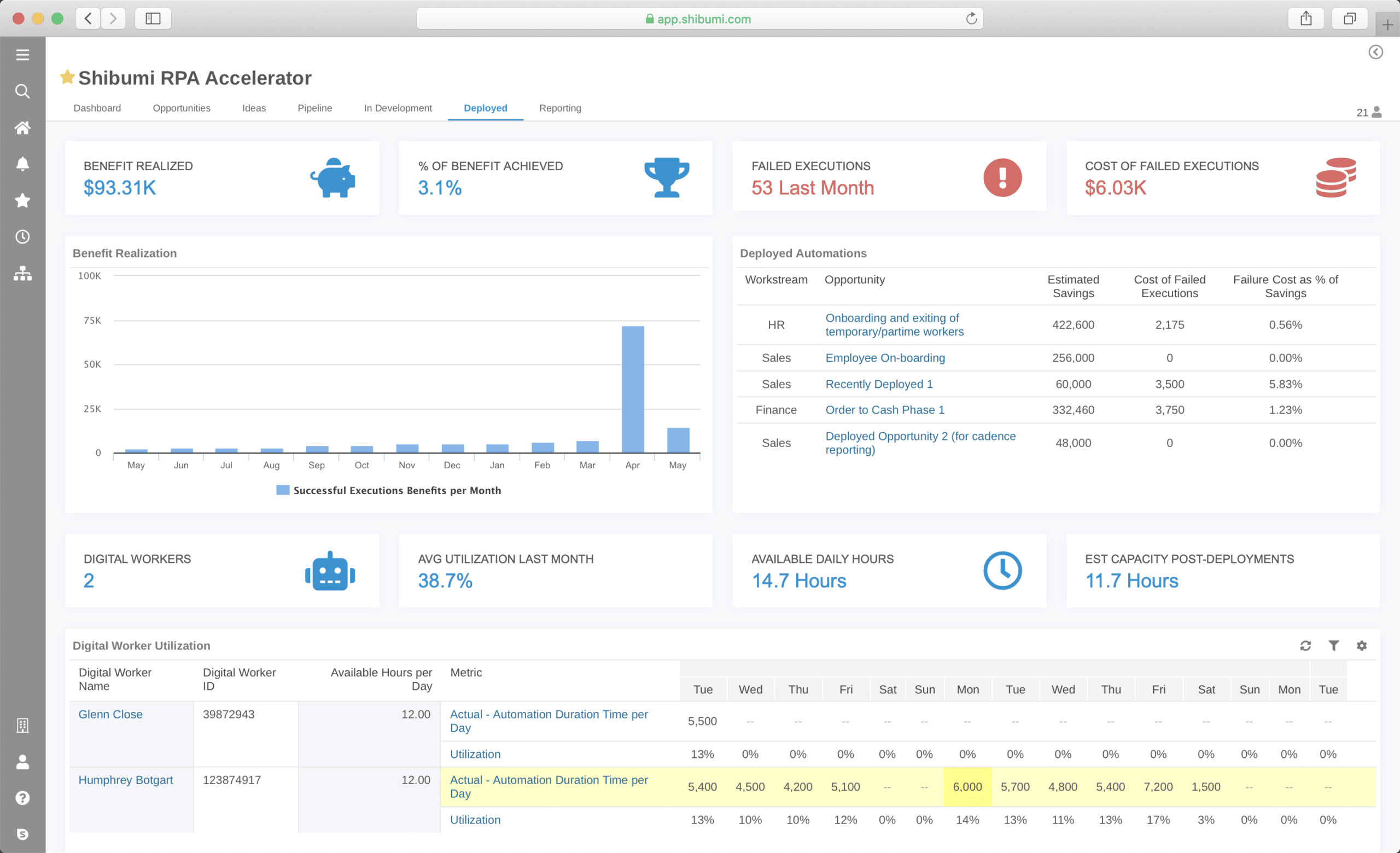Digital Transformation Management Software
Manage your Digital Transformation Program with Shibumi
Digital Transformation leaders use Shibumi to manage the delivery of value from the many initiatives that make up your transformation program
Track Transformation Program Data
Manage Pipeline & Delivery
Support Value-Focused Decisions
Report Value In Real-Time
Track Enterprise Project Data
The Shibumi Digital Transformation Accelerator is your single source of truth for all of your Automation Program data.
Scale your Project Pipeline
Set your high level targets and engage your frontlines to generate ideas from across your organization
Deliver Value
Provide Program Leadership with the information they need to ensure alignment, transparency and accountability to achieve maximum Return on Investment from your program
Dashboards & Reports
The Shibumi Transformation Accelerator gives you back hours per week by automating your Stakeholder Reporting such as Executive Dashboards and Presentations.
Executives
Give Executives Real-time visibility to transformation program data in a single location.
Digital Transformation Program Leaders
Shibumi’s Accelerator acts as the guardrails for sourcing and managing pipeline through to real business outcomes.
ePMO Team-Members
The Accelerator from Shibumi is designed specifically with the ePMO RPA CoE in mind, helping you manage transformation targets from idea through to implementation, all in a single app.

Deliver deeper insights
By integrating with the applications your data lives in The Shibumi RPA Accelerator helps you deliver a 360 degree view of the information you need to make real-time, value based decisions to maximize the ROI delivered by the program.
Integrate with your existing tools
With Shibumi there is no need to ask your teams to leave the tools they love. Shibumi integrates with almost all modern applications including Automation Anywhere, Blue Prism, UiPath, JIRA, MS Project Online and many more. Capitalize on the investment you’ve made in other technologies whilst enabling your teams to work in the ways that suit them best.
Trusted by leading global enterprises in every industry
The importance of business transformation plans
Business transformation is like a highway: fast, thrilling and full of split-second decisions. It’s well worth the journey, as this particular road can lead to all kinds of benefits — including streamlined workflows, improved customer experience and more. To make sure you navigate this highway safely and confidently, you need to know what to expect — and that’s where business transformation plans come in.
A business transformation plan is your roadmap through the various goals, phases and challenges associated with large-scale change. This type of strategic planning is a necessity for reasons such as:
- Organizational Structure: Altering your business process requires a lot of tasks performed by a lot of different people. A transformation strategy helps ensure all those moving parts are happening at the appropriate times and working in harmony.
- Vision Clarity: As your business transformation journey progresses, it’s helpful to have a clear view of the path ahead. When designed thoughtfully, business transformation plans provide this clarity, allowing you to see possible next steps and the work required to bring goals to fruition.
- Program Analysis: How is your transformation journey impacting the customer experience? What is the current return on investment (ROI), and how is it projected to grow? Which transformation efforts have been most successful? Strategic planning makes it easier to answer these questions through data analytics, giving you the structure necessary to learn from every decision you make.
- Stakeholder buy-in: When it comes to transformation, every employee, manager and leader is a stakeholder; in fact, even customers will be impacted by many of the associated changes. A business transformation plan is a critical tool for illustrating value propositions to these stakeholders and winning their approval, support or patience.
Simply put, a business transformation strategy is the best way to make sure you’re getting the most out of your transformation efforts, helping your business evolve in all the right ways.
Key objectives of business transformation
Because business transformation can take so many different forms and directions, it’s often helpful to begin by identifying key objectives. Each objective supports success by supporting and enhancing the differentiators that make your company unique, allowing you to be a stronger, more competitive player in the business landscape.
Here are a few goals for your transformation program:
Adapting to modern solutions
It rarely makes sense to continue doing things the hard way when simpler, faster and more reliable solutions are just waiting to be implemented. When it comes to digital technology, however, there’s one big obstacle: deciding how to transition from outdated to modern approaches without losing your company’s foundational values. Business transformation, then, must include adaptation as a key objective. If you don’t lay the groundwork for this gradual shift in thinking, behaving and making decisions, you run the risk of becoming a tangled piecemeal of tech solutions instead of a smart, modern organization.
Creating memorable experiences
In an increasingly digital world, experiences are more important than ever. To ensure simplicity, effectiveness and delight every time a customer or employee engages with your brand, you need to transform your business process and take full advantage of digitization. Often, that means significantly altering your company’s DNA. Because such an undertaking can quickly become nebulous and difficult to manage, it’s helpful to define the business transformation journey by putting employee and customer experience at the heart of your strategic planning.
Making value-based decisions
There’s no single “correct” way to manage the transformation process, which means there’s no rulebook to help you make the right decisions. As such, one of the key objectives of your business transformation journey should be to make choices based on concrete, measurable value. For example, it’s tempting to gather as much technology as possible in an effort to become digitized — but this only leads to wasted time, money and energy. Instead, choose digital technologies that solve specific problems or fill well-identified needs — that way, your decisions create real value instead of confusing and complicating the transformation process.
Capturing and tracking data
Customers and employees alike are constantly creating data. To utilize that data across your organization, you need a way to capture and track it across all your systems, programs and business touchpoints. However, that’s often easier said than done — especially since data comes in so many formats. That’s why many companies consider data capture a critical objective of their transformation. Data is becoming a new language, and you need to know how to speak it.
Automating data analytics and reporting
Business transformation can’t simply capture data from users; it must also support the analytics and reporting necessary to turn that data into valuable insights. For this reason, another key objective of business transformation is to deploy automation solutions that simplify the data analytics process, minimizing the risk of human error and enabling better, more accurate decision-making. Furthermore, it’s far easier to create a foundation for future transformation with automation at your disposal.
Overcoming common obstacles in business transformation
While it’s critical to create a business transformation strategy and identify key objectives, it’s equally important to understand what not to do. The unfortunate truth is that, for all its benefits, technology isn’t always easy to leverage — especially when there are no rules for how, when and where to implement it for best results.
As such, it’s often helpful to look ahead and anticipate obstacles in business transformation, giving yourself the foresight necessary to proactively address those problems.
Problem: Costs are difficult to project and manage
Business transformation is all about change. Too often, those changes come with unfamiliar costs — like maintenance for a new digital tech tool or added security measures on a unique program. For many companies, the result is a business transformation process that, while strategic, quickly becomes financially overwhelming.
Solution: Leverage technology effectively.
Although all technology comes with costs, some of which are especially difficult to project, it’s possible to mitigate these budget concerns by building your tech stack with an eye toward cost-effectiveness. For example, automation often saves money by reducing the time and effort spent on manual tasks — which means those resources can go toward a larger-scale or more intricate tech solution.
Problem: Customers are often overlooked
A flawless customer experience should be the goal of many transformation initiatives. However, in the process of bringing that customer experience to fruition, the customers themselves are often overlooked. Companies feel the ends justify the means and, as such, are too quick to dismiss concerns about how data migration or new software deployment will impact day-to-day operations.
Solution: Create customer-facing announcements.
Because customers are impacted by your transformation efforts, it makes sense to bring them into the process. Public-facing announcements help your users see forthcoming changes as a journey you’re taking with them — one that seeks to benefit all parties and, in the meantime, will require a little patience. This is also a good opportunity to clearly state the interim solutions you’ll offer to help customers navigate while you’re effectively under construction.
Problem: Technology is constantly changing
Many companies wonder whether their current transformation strategy is fated to become obsolete every time a new tech solution is released. They hesitate to make any significant alterations to their business model because they fear they’ll have to constantly reinvent themselves.
Solution: View business transformation as a journey, not a destination.
The goal of business transformation isn’t to achieve some set level of digitization that equates to guaranteed success. Instead, it’s about setting yourself up for constant evolution, allowing you to adapt to any new updates to automation, analytics, cloud solutions or other tech tools.
Software solutions for business transformation
The key to successful evolution is having the right business transformation software. Organization leaders use Shibumi to manage the many initiatives that make up a complete transformation program.
Track transformation program data
A single source of truth with real-time visibility to your program’s status and KPIs.
Manage pipeline and delivery
Scale and manage your pipeline of transformation opportunities from idea through to delivery to value realization.
Support value-focused decisions
Provide program leadership with the information they need to maximize the ROI from your Transformation Program.
Report value in real time
Put hours back in your week with zero-effort Stakeholder Reporting via Executive Dashboards and Automated Presentation Creation.
Track enterprise program data
The Shibumi Digital Transformation Accelerator is your single source of truth for all automation program data.
Scale your program pipeline
Set your high-level targets and engage your frontlines to generate ideas from across your organization.
Deliver value
Provide Program Leadership with the information they need to ensure alignment, transparency and accountability to achieve maximum Return on Investment from your program.
Dashboards and reports
The Shibumi Transformation Accelerator gives you back hours per week by automating your Stakeholder Reporting with Executive Dashboards and Presentations.
Executives
Give Executives real-time visibility to transformation program data in a single location.
Transformation Program Leaders
Shibumi’s Accelerator acts as the guardrails for sourcing and managing the transformation process through to real business outcomes.
ePMO Team-Members
The Accelerator from Shibumi is specifically designed with the ePMO RPA CoE in mind, helping you manage transformation targets from idea through to implementation — all in a single app.
Deliver deeper insights
By integrating with the applications your data lives in, the Shibumi RPA Accelerator helps you deliver a 360-degree view of the information you need to make real-time, value-based decisions that maximize the program’s ROI.
Integrate with your existing tools
With Shibumi, there’s no need to ask your teams to leave the tools they love. Shibumi integrates with almost all modern applications, including Automation Anywhere, Blue Prism, UiPath, JIRA, MS Project Online and many more. Capitalize on the investment you’ve made in other technologies while enabling your teams to work in the ways that suit them best.
Trusted by leading global enterprises in every industry
“In a prior role, I worked on a transformation program where we used an Excel-based tracker. Shibumi’s web-based tool was a much better solution for our needs. We have never had this level of transparency on strategic initiatives.”
Transformation Office Head, European Manufacturer
“Shibumi has played a key role in supporting our ambitious transformation goals. Before deploying Shibumi, it often took us weeks to assemble each executive update, but we now have real-time access to critical strategic data.”
Corporate Programs Manager, North American Life Sciences
“Shibumi has been an important foundation for the delivery of a critical transformation program. With Shibumi, initiative teams are empowered for flexible execution, while program leadership has the information to identify emerging delivery risks, maintain stakeholder alignment and confirm progress toward our goals.”
Head of Results Delivery Office, Global Healthcare Manufacturer
“Implementing our advisor’s methodology through Shibumi helped us bring efficiency, accountability, and transparency to a program that spans all of our transformation objectives, geographies and business units.”
Corporate Transformation Lead, Global Consumer Goods
“The original business case I made around Shibumi was, ‘I’m not going to grow my staff, I’m going to grow the organization through the tool [Shibumi].’ That was at least a half-million dollars of annual savings.”
SVP, Multi-National Financial Institution







